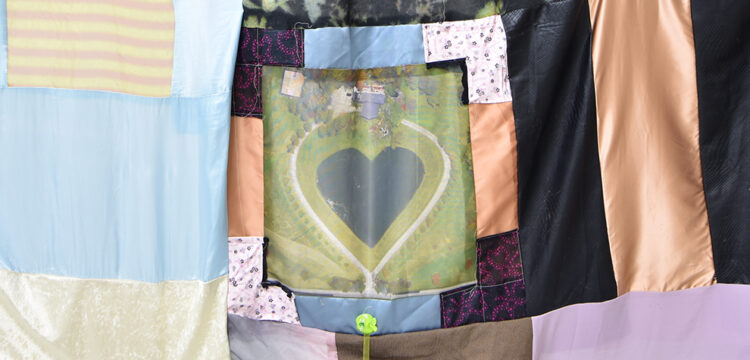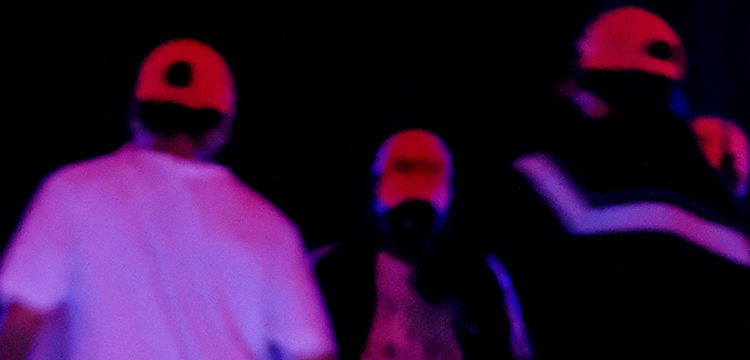The Purifying Ritual
Cocoricò Tapes: Masquerade, Sweat, and Sound System
By resurrecting a treasure of unpublished tapes and adding the latter to a series of in-depth interviews with the Cocoricò’s most avant-gardist era protagonists, the newly-released film Cocoricò Tapes by Francesco Tavella drags us back into the mad, visionary, hedonistic experience that was a Saturday night at the Cocoricò at the peak of its creative turmoil. Inspired by the film’s first tour and a discussion around the overlaps between architecture and club culture that took place after the film’s projection in Modena, Italy, this article reflects on the cultural and artistic role that the club played during the ‘90s for the Italian youth and beyond.
To us, the Cocoricò carries the legacy of a sacred temple. The mythical aura surrounding the club still attracts thousands a night between long-time devotees and new followers. Although I would not argue that today’s Cocoricò was living solely off the collective memory built around it—given that it continues to host the best of contemporary techno stars—there is something endlessly seductive in dancing within the walls of a place that made clubbing history.
The Cocoricò, dubbed “il Cocco,” has been internationally known as a Mecca of techno and house music since its opening in 1989, evolving through the decades and climbing the ranks until reaching the position of Italy’s best club and 16th best club in the world according to a DJ Mag’s 2015 ranking. After two closures, first in 2015 and then in 2019, the club re-opened in 2021 and has been active since. Located in the sea town of Riccione, with the hills at its back and the sea in front, Cocoricò’s pyramidal architecture—which strictly resembles I. M. Pei’s Louvre Pyramid, equal in age—became in itself an icon. Some invoke the club’s pyramid as a hub for mystical ascension, while others believe in its summit as a nervous centre able to catalyse the positive energy of the thousands dancing underneath. Surely, receiving the rising dawn’s light filtering through the grandiose glass walls is quite a unique experience.

Like every club culture-Mecca, the Cocoricò brims with tales often crossing the fine line between oral histories progressively adjusted through word-of-mouth and out-and-out urban legends. The story goes that, under the pyramid, the public participated in a wide spectrum of shows as various as to including Tibetan monks’ choruses; the duo Daft Punk being booed off stage; a noise guitar solo by Arto Lindsay surrounded by Cocoricò’s dancers cooking spaghetti for everyone; a DJ-set by a back-then almost unknown Aphex Twin; a 30-minutes jam session by the Indian flautist Bollivar in Morphine, the room dedicated to ambient music; Jean Paul Gaultier, Franco Battiato, and Grace Jones dancing in the crowd, to name a few. Resident DJs Cirillo, Ricci, and Saccoman—the local stars from the first infamous Cocoricò’s era—preceded world-praised guest DJs such as Carl Cox, Chris Liebing, DJ Ralf, Sven Väth, and Skrillex, among others.

In its newly-released film Cocoricò Tapes, writer and director Francesco Tavella gathered some of the club’s oddest and most visually compelling moments between 1989 and 2001—what could go down in history as Cocoricò’s highest peak of artistic avant-garde. On December 12, 2023, the film was screened at the Cinema Astra in Modena, as part of an ongoing Italian tour of independent movie theatres. Following this screening, curators and producers Chiara Ascari and Francesco Ninno organised an event on the overlaps between architecture and club culture, including the participation of Francesco Tavella, the film’s director, Giacomo De Caro, PhD student in architecture at IUAV University, Gerardo Lamattina, performer and founder of the Teddy Bear Company, and Filippo Florindo, photographer and event organiser, as well as a dear lover of the Cocoricò. Drawing upon communication scholar Marshall McLuhan’s pioneering conceptualisation of the acoustic space, when we reflect on the relationship between architecture and club culture, it is crucial to include under the umbrella of architectural elements non-material components such as visual art, graphics, fashion, lighting, performance, and sound.

According to McLuhan, acoustic space is “a sphere without fixed boundaries […]. It is not pictorial space, boxed-in, but dynamic, always in flux […]. The eye focuses, pinpoints, abstracts, locating each object in physical space, against a background; the ear, however, favours sound from any direction…” The multi-disciplinary experimentations taking place at the Cocoricò in the ‘90s, under the artistic direction of Loris Riccardi, were relevant across all the above-mentioned categories. From sonic experiments with Tibetan monk choruses to some extreme contaminations with avant-garde theatre, and from the unlimited imaginativeness of the audience’s costumes to art installations, thanks to a wide array of material and acoustic design elements, “il Cocco” soon started to represent a visionary creative hub for the local and international youth. Riccardi’s provocative statements, from “Giuda is beautiful” to “The magnific obsession” and from “I will never be a space boy” to “Fuck the quiet”, appear here and there in capital letters on the Cocoricò’s walls standing out as crucial components of the club’s architecture.

The timeframe that represented Cocoricò’s queerest era oddly coincided with two events that revolutionised the Western experience and inevitably shaped its youth’s perception: the fall of the Berlin Wall and the 9/11 attack on the Twin Towers. Following a specular timeline, Cocoricò’s most extreme period of cultural and artistic experimentation began with its opening in 1989, reached its legendary peak in the mid-90s under the artistic direction of Loris Riccardi, and softened from 2001 on, the year Riccardi started to play a less significant role at the club. Cocoricò Tapes’ director and screenwriter Francesco Tavella looked at the timeframe’s overlap as more than a coincidence. Indeed, the film centres on Cocoricò’s life between 1989 and 2001 and includes fragments of newscasts covering the above-mentioned events and other major historical highlights such as the Italian political corruption scandal “Mani Pulite” [Bribesville], the Gulf War, the AIDS pandemic, and the Balkans conflict. During his artistic direction, Loris Riccardi conceived a vast array of genius scenographies for the Cocoricò—which changed on a five to six months rolling basis—directly dialoguing with the aforementioned major political events. Cocoricò Tapes’ video fragments allow us to catch a glimpse of Riccardi’s scenographies, ranging from a gigantic toy house to a moon-shaped swing hanging down from the club’s ceiling, and from a series of wall-sized fish tanks to an installation of guns as a political statement against the Gulf War.

Beyond Riccardi, the visionary team at the heart of Cocoricò’s most glorious days included director Renzo Palmieri, PR Silvia Minguzzi and Giuseppe Moratti, and legendary performer Prince Maurice. Another steady presence at the Cocoricò was the Teddy Bear Company (TBC), a group of self-defined “Teatro da discoteca” [Clubbing theatre] performers consisting of Gerardo Lamattina, Luigi De Angelis, and Silvia Calderoni. The three performed the most eccentric tableau vivant, often requiring them to stand still for four or five hours. These extreme experiments included being locked up in display cases filled with flies or covered in fake blood and hanging around as a way of representing cannon fodder. During the 90s, alongside the tableau vivant enacted by the TBC, Cocoricò’s clubbing nights hosted art installations, book presentations, various performances, and speeches by well-known intellectual figures. The pyramid was a labyrinth of indoor rooms and outdoor spaces adorned with the most sophisticated sound systems playing music ranging from techno in the main room to house in the Titilla room and from ambient in the Morphine room—often protagonists of aesthetic and sonic experiments, including when it was transformed into an indoor garden where you could just order spring water; they said, “to decompress”—to sound experimentations in Strix, a corner of the females’ restroom that included a DJ console.

As shown by the many videos appearing in Cocoricò Tapes—featuring the most curious unpublished content filmed in the club from 1989 to 2001, from live interviews and ad breaks for Italian regional TV channels to reportages aired on national news—the crowd itself played a major role in making the Cocoricò a cutting-edge Italian platform for artistic avant-garde. As design curator Catharine Rossi once said about pioneering experimental discos that opened in Italy between the ‘60s and the ‘70s and were designed by architects of Radical Design, including the Piper in Rome or the Space Electronic in Florence, such environments were “theatrical spaces where everyone was on stage, everyone was a performer.” Rossi’s statement sparks reflections on a different dimension of the clubbing experience in Italy; one where the body played a much more central role and, alongside it, so did the masquerade.
Space Electronic had in fact hosted groundbreaking theatrical performances by The Living Theatre and featured an exceptional indoor garden within the club’s walls. Almost twenty years later, The Teddy Bear Company’s tableau vivant enacted at the Cocoricò along with its Morphine room’s green installations took over these trailblazing acts of Italian club culture. In that particular historical moment, at least in Italy, clubs represented a newly born type of public space, creatively liberating, and where to experiment across disciplines. Assuredly, the Cocoricò, particularly in its earlier days, can be hailed as one of the last protagonists of the latter movement. As Loris Riccardi states at the end of the film, “…at the Cocoricò, guys, you’ve missed something.” So what was the ultimate secret behind Cororicò’s magic spell? After watching Cocoricò Tapes, one could point at a harmony of ideas among the club’s legendary team that, together with the public, enabled a space where everyone could feel like a protagonist free to enact their weekly carnival; a space that encouraged and celebrated the act of being frivolous yet with cleverness, always.





